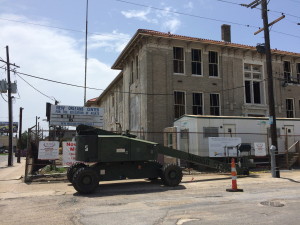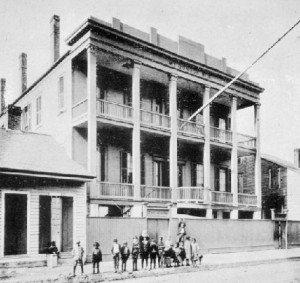
McDonogh No. 16 School/New Orleans Center for the Education of Adults, 1815 Henriette Delille Street (2014)
The post below reflects research which was conducted by Mishio Yamanaka, a Ph.D. student in history at the University of North Carolina at Chapel Hill. Mishio studies African American communities in post-Civil War New Orleans and their struggles to secure equal access to public accommodation. She is currently looking for any students who attended or teachers who taught at McDonogh No. 16 School during the 1960s and 70s.
The Fillmore School was the predecessor of the school known to most New Orleanians as McDonogh No. 16. Named for President Millard Fillmore, the Fillmore School was originally built in the 1850s as a white-only school, like all of the public schools in New Orleans, despite the fact that taxes paid by all New Orleanians funded their establishment and continuance. The Fillmore Boys School was located on Pauger Street between Marais and Saint Claude Avenue. The state constitution adopted after the Civil War in 1868 was very progressive in that it assured all citizens of access to public education and outlawed segregation in public schools. Despite attempts over the course of three years to thwart integration, the school was one of the desegregated schools in New Orleans from 1871 to 1877, before the local school board decided to “resegregate” every school. The overwhelming majority of the students of color at the Fillmore Boys School were Creoles of color, reflecting that population’s commitment to integration. Mishio conducted extensive research in the records of the Orleans Parish School Board in the University of New Orleans’ Special Collections Department. She discovered an 1877 Student Register from the Fillmore School which lists over 600 students. (More information on the school and the 1877 register can be found on the project website: fillmoreschool.web.unc.edu) The school board mandated re-segregation of the schools in July 1877. In recognition of funds received from the estate of public school benefactor John McDonogh, the Fillmore School was renamed as McDonough No. 16 in 1883 and for a long time, it was operated as a white school. The school admitted both boys and girls beginning in 1880. In 1962, after being “for whites only” for eighty-five years, McDonogh No. 16 finally admitted African American children for the first time in the twentieth century. McDonogh No. 16 School closed due to declining enrollment in 1978. The school building was used as the New Orleans Center for the Education of Adults (NOCEA) from 1978 to 2005 and now is being converted into apartments for the elderly.
For more information on the fascinating research Mishio is conducting, please visit the project website entitled, “The Fillmore Boys School in 1877.” (http://fillmoreschool.web.unc.edu). Due to the lack of sufficient historical records, in particular during the 1960s and 70s, researching that period is difficult. Mishio would like to meet and interview former McDonogh No. 16 students and teachers. Any information would be appreciated. Please email Mishio Yamanaka (yamanaka@live.unc.edu) if you have any remembrances or feel free leave comments on this post.




I hope you will find this note useful in your research and wish I had seen it sooner.
I attended McDonough 16 as a second grader in 1966. My family moved to New Orleans following Hurricaine Betsy so that my father could find work. I moved from a completely segregated town in Alabama so there was much to learn when we moved into a culturally diverse neighborhood and attended a school where for the first and only time in my life, I was in the minority. I’m surprised to read in your introduction above that the school was still all white in 1962. When I attended, there were white children but the population was mostly black and brown children.
I am writing a memoir and was trying to recall McDonogh 16 Day, which this school still celebrated when I attended. That is how I found your website. I was very young so I don’t know how much I can help but would be happy to share anything you might find interesting.
Hi Cindy, Thank you so much for sending this response. Dr. Mishio Yamanaka, a personal friend of mine, has received her doctorate but is planning to continue with her work on this subject, possibly for an upcoming book. She is presently back in Japan but I will have her contact you personally. Once again, thank you for sharing this information with us….Lolita
The first school I attended in 1961 through second grade was McDonogh 16.